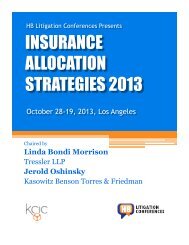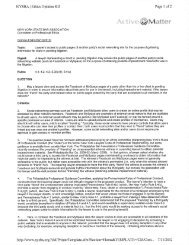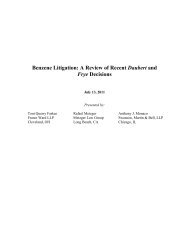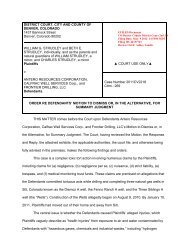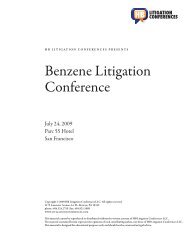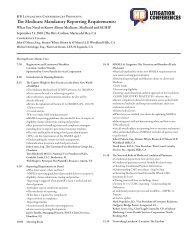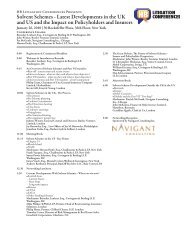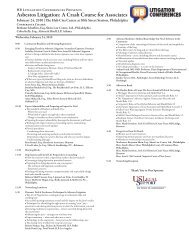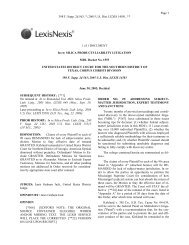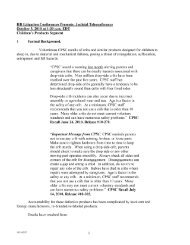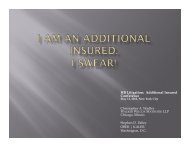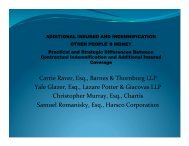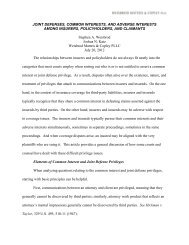Is My Drywall Chinese? - HB Litigation Conferences
Is My Drywall Chinese? - HB Litigation Conferences
Is My Drywall Chinese? - HB Litigation Conferences
You also want an ePaper? Increase the reach of your titles
YUMPU automatically turns print PDFs into web optimized ePapers that Google loves.
concern at the moment remain 2004‐2008 in<br />
Florida, when an estimated 60% of all the<br />
drywall in question entered the market.<br />
Visual Clues<br />
Several visual clues may be used to detect<br />
<strong>Chinese</strong> drywall. A/C coils within walls can<br />
corrode in as little as four years, and electrical<br />
wiring may turn black. Cook top elements will<br />
corrode and copper plumbing and air<br />
conditioning coils corrode in just a few years.<br />
While many companies are now marketing “test<br />
kits,” the State of Florida considers these<br />
generally to be ineffective and recommends a<br />
visual inspection. Even a casual inspection by a<br />
homeowner may be sufficient, as the “KNAUF”<br />
branding isn’t difficult to spot anywhere that<br />
drywall is exposed; for example, in the attic<br />
behind insulation.<br />
Odors<br />
The most obvious red flag for appraisers is the<br />
sulfur smell. However, the smell can be<br />
contained by encapsulating paint or masked. If<br />
the wallboard has been replaced, the smell will<br />
not be noticeable. Excessive corrosion of metal<br />
construction components that came in contact<br />
with the sulfur‐based gas may or may not be<br />
visible.<br />
Laboratory testing<br />
Non‐destructive testing seems to be falling<br />
short. EMSL labs have not been particularly<br />
successful with air samples as the gases<br />
measure in the parts per billion in open spaces.<br />
Corrosion scrapings (the oxidation and black<br />
film) work somewhat better.<br />
Destructive testing seems to work best. Dr.<br />
Edward A. Sobeck, PhD of AssuredBio.com the<br />
University of Tennessee and Irving Kraut, an<br />
industrial hygienist from Naples Florida have<br />
developed a process using Fourier Transformed<br />
Infrared technology to detect the difference<br />
between American and <strong>Chinese</strong> drywall from a<br />
2”x2” sample.<br />
SUITE 650, FOURTH AVENUE<br />
SEATTLE, WASHINGTON 98121<br />
PHONE 206-623-2935 FAX 206-623-2985<br />
HTTP://WWW.GREENFIELDADVISORS.COM<br />
<strong>Chinese</strong> <strong>Drywall</strong><br />
June 5, 2009<br />
Page 3<br />
To compound the problem, some homes were<br />
built or rebuilt with a combination of <strong>Chinese</strong><br />
and American drywall.<br />
Remediation<br />
Because the extent and long‐term effects of<br />
the problem are still being discovered, a certain<br />
cure is still yet undefined. As in many<br />
impairment cases, the cost of a total cure may<br />
prove to be infeasible because the value added<br />
by the cure exceeds the cost of the cure.<br />
The most expedient action is to replace the<br />
defective drywall with good drywall. This<br />
eliminates the emission of the sulfur‐based gas<br />
and removes the smell. It stops the progression<br />
of deterioration of metal construction<br />
components that come in contact with the<br />
sulfur‐based gasses. However, even after<br />
replacement of the drywall, there may be<br />
substantial residual effects from the drywall.<br />
The sulfur‐based gases have sped the corrosion<br />
of metal construction components such as<br />
pipes, electrical components and metal wall<br />
studs, thus shortening the economic life of<br />
these components.<br />
Accordingly, replacement of the drywall may<br />
not effect a total cure. Residual effects might be<br />
classified as incurable physical deterioration.<br />
Obviously excessively corroded components<br />
could be replaced with new components.<br />
However, essentially all the known cases of use<br />
of this drywall are in houses less than eight<br />
years old. Replacement of plumbing in nearly‐<br />
new houses may not be feasible if the copper<br />
components can still provide years of service.<br />
Certainly metal studs, as are used in commercial<br />
construction, present a larger concern.<br />
If the effects of corrosion could be gauged with<br />
certainty, they might have the same effect on<br />
value as‐if the builder had installed used piping<br />
instead of new piping when building the house.<br />
If the effects could be known to be curable<br />
(now or later) with certainty, they would



